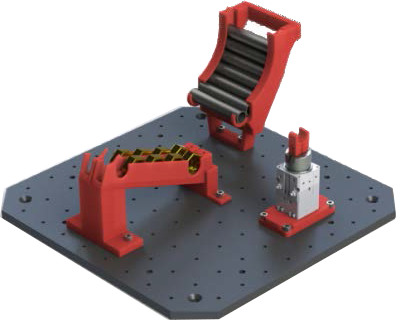Flexible Automation is the ability for a robotic system to be rapidly and easily reconfigured and re-tasked according to changes in a production. Enabling Flexible Automation by Robotic Automation Modules results in a situation where adjustment to – and changes in – a production are merely a matter of choosing and plugging in the right modules.

All objectives serve to increase the global market share for robotic automation in the European manufacturing industry. Globalisation has led to a massive outsourcing of manufacturing production from high wage countries in the west to low wage countries in the east. One response to combat this outflow has been increased automation, to minimize the labour cost percentage and thereby maintaining a cost-efficient production. However, this response has only been possible for automation of production lines characterized by low-mix/high-volume. High-mix/low-volume production in Europe still suffers from outflow to low wage countries, making it difficult for high-wage countries in Europe to compete.
- Increased productivity of eight use cases representing an industry demand for flexible automation. Flexible automation enables automation of many of the currently non-automated processes in high-mix low-volume productions. As such the productivity per employee is increased, thus increasing the competitiveness of the European SME-like productions. The use cases are provided by four end-users (two each) during RAMPup. Towards project-end these solutions are utilized as pilots and catalysts for the future exploitation of the project results.
- Reduced total cost of ownership of robotic workstations and process modules. This is achieved by reusing both the Modular Automation Workstation and Robotic Automation Modules for manufacturing multiple products. For each situation where the workstation or a module is reused during its life span the total cost of ownership is reduced. The total cost of ownership is difficult to predict due to this reuse of components in future production of as yet-unknown products.
- Increased reusability of software and hardware in system integration, decreasing the cost of robotic automation. The cost of installing automation is equally important to the final cost of a product, and the return on investment (ROI) is based on predictions of future sales and the overall production cost per unit/product. Thus decreasing the cost decreases the investment and improves the competitiveness for the end user. Enabling reuse of previously developed functionality both in terms of hardware and software decreases the investment cost of robotic automation for the end users. The decrease in investment cost generates an increased market for system integration as more industrial processes can be automatized with a positive business case. System integrators can develop modules and sell the same module to multiple end users as an off-the-shelf product. Robotic process modules are made available as turn-key products in the same way as robotic manipulators.
- Six robotic automation solutions at TRL 7 for currently manual processes identified across eight use cases with four different manufacturing facilities. These solutions are integrated as Robotic Automation Modules on a common scalable integration platform. To enable module coordination and orchestration and communication between them a central framework is needed. RAMPup provides an integration platform serving as such a framework, for all users – Research and Technology Organizations (RTO), system integrators, and the end users. The platform is scalable, to accommodate workstations of different sizes and future solutions beyond project end. Six general process functionalities have been identified and selected to be integrated in RAMPup:
- Handling (H) covers the ability to perform part localisation and pick-and-place operations. Provides the hardware for grasping and the necessary sensors for localising an object. It
provides the software control strategies enabling a robot to move an object from A to B. - Screwdriving (S) covers the ability to locate a threaded hole and apply a screw. Provides a fastening tool and possibly a screw dispenser and a sensor to locate a threaded hole. It
provides the software control strategies for applying and fastening the screw. - Riveting (R) covers the ability to locate a hole and apply a rivet. Provides a riveting gun, and possibly sensors to locate the hole. It provides the software control strategies for applying the rivet and activating the rivet gun.
- Dispensing (D) covers the ability to apply glue, lubricant, or other similar fluids and gels. Provides a dispensing tool. It provides the software control strategies for applying the
substance smoothly along a predefined trajectory. - Press (P) covers the ability to press-fit an object into another. Provides the press and the software control strategies for placing the objects in the press and activating the press.
- Insertion (I) covers the ability to perform peg-in-hole operations. Provides the hardware for force-torque sensing and the software control strategies for performing the insertion
operation.
- Handling (H) covers the ability to perform part localisation and pick-and-place operations. Provides the hardware for grasping and the necessary sensors for localising an object. It